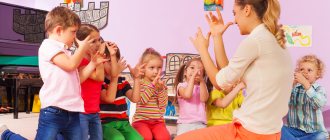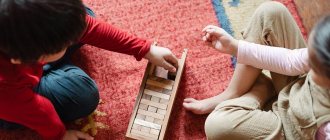Physical education class in the form of relay races.
Physical education lesson in the preparatory group in the form of relay races
PE instructor: Nurieva Yu.G.
Type of activity: physical education
Type of lesson - in the form of relay races
The learning stage is improvement.
Equipment.
Wooden sticks; 2 turning chips; 2 metallophones; 2 konats; 2 balls; medals with inscriptions according to the number of children.
Target.
An interested child who improves his motor skills in a playful and competitive situation.
Tasks:
1. Preserve and strengthen the health of children.
2. Consolidate and improve motor skills during relay races.
3. Develop physical qualities: speed and agility.
4. Form children’s responsibility towards their team, directing children’s attention to the correct execution of movements.
5. Foster a sense of camaraderie and independence.
Preliminary work.
Learning and consolidating motor actions.
Conversations about physical qualities: speed and agility, in what life situations these qualities are necessary.
Introductory part.
Alignment.
Instructor:
Be equal! Attention! At ease!
Guys, today we will go with you for speed and agility. During the lesson we will compete, which means completing tasks quickly, correctly and deftly. Whoever copes with these tests will certainly acquire both speed and agility. And we have already told you that a strong and resilient person can be fast and agile. Do you want to be like this? Then go ahead! But before the relay races you need to do a little warm-up.
Then to the right, in a circle, march in steps (various types of walking are performed).
Walking is usual in a column one at a time; walking on toes, arms up; walking on your heels with your hands behind your head; normal running; running, raising your knees high; running while following the command “in a circle”, switching to normal walking, restoring breathing.
Children line up in one line: first, second, pay off.
Instructor:
Everyone, ready!
Children:
Yes, we are ready.
Instructor:
Well, then let's start our competition.
1 relay race with running “Pass the baton.”
At the signal, the first child with a stick in his hands runs to the turning chip and, having run around it, passes the stick to the next player, and he himself stands at the end of the column.
Methodical instructions. The second player cannot start running without waiting for the first player. While waiting, you cannot enter through the starting line.
2 relay race with jumps “Jumping over obstacles, back with a snake”
5 sticks are laid out parallel to each other at a distance of 60 cm. At the signal, the first player jumps over them with his feet together forward and, having run around the turning piece, returns, running around the sticks like a “snake” and passing the baton by touching his hand, stands at the end of the column.
Methodical instructions. Keep your legs together when jumping.
3 relay race with jumps “Jumping right-left”
There is a konat on the floor. The first player starts the relay race by jumping over the rope sideways to the right and left, moving forward and, having run around the turning chip, returns back. Having passed the baton by touching his hand, he stands at the end of the column.
Methodical instructions. Keep your legs together when jumping sideways.
4 relay race with climbing “Into the tunnel “on your bellies””.
Children stand close to each other, legs wide apart. The last player lies on his stomach and crawls forward on his belly. As soon as the last player has disappeared into the tunnel, the second to last player immediately crawls after him. etc. The player, getting out of the tunnel, quickly stands in front of the column and spreads his legs wide. The team whose players finish the relay faster wins.
Methodical instructions. Crawling on your stomach. Don't forget to spread your legs to the sides when leaving the tunnel.
5 relay with the ball “Pass the ball”
Children stand in a column with their hands raised. The first player has a ball in his hands (can be stuffed). At the signal, he passes the ball back over his head. As soon as the ball reaches the last player, he immediately runs to the beginning of the column, stands in front of the first player and, also over his head, passes the ball back. The team whose players finish the relay faster wins.
Methodical instructions. Keep your arms up until the end of the relay. If the ball falls, the game continues from where it was interrupted. The one who missed the ball runs after the ball.
6th relay race “Merry Musicians”
At the finish line there are metallophones on stands. At the signal, the first player runs to the metallophone, takes a hammer and runs it across the plates, then puts the hammer down and returns, passing the baton by touching his hand to the next player, and stands at the end of the column.
Instructor
: Our competition is over.
Instructor:
Attention! Get in the line for the award ceremony! You had good training and completed all the tasks with dignity, demonstrating such physical qualities as speed and agility. This means you have become strong and resilient. Awarding medals.
Article “Relay races” in preschool education article on physical education
Relay games in preschool educational institutions
One of the most important areas of pedagogical activity in preschool educational institutions is the physical education of children.
An important place in the work on the development of motor activity of preschoolers is given to outdoor games with rules, which are divided into plot and non-story.
Games - relay races belong to the group of simple outdoor games with rules and are the most exciting form of physical activity for children, as they guide them towards achieving a specific goal.
Games - relay races are team outdoor games with rules. These games are characterized by the joint activities of teams, goals, the subordination of personal interests to the interests of the entire team, and also by the fact that the victory of the entire team depends on the actions of each player.
Games - relay races teach children to coordinate their actions with the actions of their comrades.
In each relay game, a number of tasks are simultaneously solved.
Motor skills are consolidated and improved, the ability to navigate in space is developed, physical qualities are developed: agility, speed, endurance, coordination of movements, accuracy, speed of reaction to a signal, etc.
Along with this, children develop courage, independence, determination, discipline, etc. There is a comprehensive development of children’s physical, moral and volitional qualities.
Games - relay races with children of senior preschool age can be held:
- for the purpose of general and special warm-up; improving the emotional state of children; repetition and consolidation of individual exercises or their targeted use for the development of certain motor abilities.
- before studying new material in order to repeat and consolidate the learned exercises, related in structure to new motor actions. Relay races are selected that include one or two tasks, simple in organization and requiring a minimum of time for planning. For the same purpose, complex relay races up to medley relays can be used, using and installing various equipment.
In relay races for preschoolers, the following types of movements and their combinations predominate;
1) running with throwing;
2) running with crawling under various projectiles and climbing over obstacles;
3) running with jumping on objects and jumping or jumping over obstacles;
4) running while maintaining balance on various apparatuses;
5) running while carrying balls, hoops and other objects in combination with additional movements;
6) running while dribbling the ball with one hand and throwing it into the basketball basket;
7) running with crawling and climbing on gymnastic equipment;
 running “snake” between objects;
running “snake” between objects;
9) walking with stepping over objects;
10) moving in various ways on the floor and sports equipment.
Each relay game, depending on its complexity, may contain in a certain combination from 2 to 10 exercises from the main types of movements familiar to children.
The specificity of relay games is that short periods of increased physical activity alternate with rest, when physical activity is reduced to a minimum. But emotional intensity remains high, because children’s attention to further completion of tasks does not weaken. Therefore, throughout the entire game - relay race, the teacher needs to regulate the emotional load, teach children to show a sense of proportion, and avoid excessive excitement.
The physical load in a relay race depends on the types of basic movements used and on where the games take place - relay races, in the gym or on a kindergarten site or on an obstacle course.
In relay games there are three types of competitions:
— Individual or personal championship (available to children from 5 years old and is held on the principle of “who is better”).
Such a competition makes it possible to evaluate the quality of movements performed by each child. When this type of competition is used correctly, the number of errors is reduced; the time required to perform movements is reduced.
— Collective or team championships are held on the principle of “whose team will perform faster or better?”
This type of competition helps to foster a sense of responsibility towards comrades, creates a community of interests and joyful experiences, inspires respect for each other, and pride in the successes achieved. This type of competition is used at the stage of improving motor skills and is available to children from 6 to 7 years old.
- Individual - collective championship is held according to the principle “the one who completes it faster will win, and the team with more winners will win.”
This type of competition helps children develop the ability to combine personal and collective interests, is used at the stage of consolidating and improving motor skills and is available to children of the 7th year of life.
Based on the number of tasks included, they are divided into simple and complex relay races.
Simple relay races - include one or two simple tasks; dribbling a ball, carrying objects, climbing through a hoop, crawling on a bench, walking while maintaining balance, etc.
Complex relay races - include more than two tasks, tasks can act as obstacle courses. According to the requirements for completing the task, relay races are divided into strictly regulated and arbitrary.
Relay races are divided into linear, counter and circular.
Linear is when children are divided into two teams and line up against each other. When given a signal, they perform game tasks. Circular is moving in a circle.
There are also relay races in which tasks are performed by alternating movements of 2 - 3 or more people.
Taking into account the classification of outdoor games and relay games and their diversity, teachers can solve a number of educational and educational problems; for this they need to know the methodology for conducting relay games.
How to select games?
Games - relay races should ensure the diversified development of children's motor skills, as well as contribute to the formation of the ability to act in a team. It is necessary to use games—relay races—not only with varied content, but also with different organization of children.
When selecting games - relay races, the teacher is guided, first of all, by the level of preparedness of the children and the degree of mastery of one or another type of movement.
The main requirement that must be followed when selecting motor tasks for games is relay races, compliance of the content of game actions and rules with the age characteristics of children, their skills and abilities.
It is necessary to take into account the general level of physical and intellectual development of children of this age group, the level of movement technique, the level of motor skills; the health status of each child, individual characteristics, location of the game - relay race, time of year.
When selecting relay games, you need to take into account the time of the day; it is best to hold relay games in the morning.
When selecting relay games, you must take into account:
1. Pedagogical tasks that will be solved in games - relay races.
2. The form of the lesson, which includes a game - a relay race.
3. Composition of teams by number of participants, by motor abilities, by age and gender.
4. Level of physical fitness of children.
5. Conditions and location of the game - relay race: dimensions of the hall or site.
6. The condition of the participants, the nature of their activities before the game - the relay race and immediately after the relay race.
In preparation for the event, it is necessary to prepare the site, attributes, mark places for building teams; think over rewards (tokens, medals, certificates, prizes, gifts), musical accompaniment, a surprise moment (the appearance of a hero).
Children are divided into two teams with the same number of children, and a team captain is selected. When holding games - relay races with preschool children, there are 2 teachers - these are judges.
The judges follow the execution rules and award points. The explanation of the relay races should be brief and understandable. The game begins at a conventional signal (a command to develop accuracy and speed in children, a whistle, a clap of hands, a wave of a hand or a flag.)
It is recommended to use various commands and signals in order to develop the accuracy and speed of motor reactions in children.
The assimilation of the game and the behavior of children during the game largely depend on the correct management of it. It is necessary to start the game in an organized and timely manner. The delay reduces the emotional mood of children. It is necessary to teach children to consciously follow the rules of the game.
The game should not be stopped by shouting or a sharp command; children should be taught to stop on a conditioned signal, on a whistle. The game must be managed in such a way that the process itself gives children pleasure.
The leader must interest the children in the game and captivate them. In outdoor games, it is difficult to take into account the capabilities of each participant, as well as his physical condition at a given time.
Therefore, it is not recommended to immediately carry out a game - a relay race of high mobility, as this can cause excessive muscle tension.
It must be taken into account that as the emotional state of the players increases, the load increases. Children, carried away by the game, lose their sense of proportion, wanting to surpass each other, do not calculate their capabilities and overexert themselves. The team that finished the relay first is considered to be the one whose participants completed the task last, the participant passed the baton to the first and he raised his hands up.
When evaluating a relay race game, the teacher notes its positive aspects, names the children who successfully completed the game tasks, showed courage, endurance, and friendly mutual assistance.
The results of completing game tasks in relay races should be assessed fairly, since children of older preschool age can objectively assess the speed of performing exercises and react very jealously to bias. Different numbers of points for completing tasks can be awarded only if two or more teams complete actions at the same time. Teams receive points for each relay race. These can be tokens or badges that the referee gives to the team captains. You can also award points for completing tasks on the scoreboard. The debriefing at the end of the competition begins with the losing team, and the winning team is declared last. Prizes are awarded to teams publicly.
It is necessary to teach children to experience failure and cope with negative emotions. However, it should be noted that relay games should bring joyful experiences. Elements of competition encourage children to be very active, to demonstrate various motor and volitional qualities (speed, agility, endurance, independence, perseverance).
Thus, the use of games - relay races in working with children helps teachers solve educational and educational problems.




